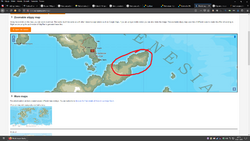Grenesia
This article is incomplete because it is pending further input from participants, or it is a work-in-progress by one author. Please comment on this article's talk page to share your input, comments and questions. Note: To contribute to this article, you may need to seek help from the author(s) of this page. |
Commonwealth of Grenesia Ṗэчпосполита Ґрэнэска (Grenesian) Zhèchpospolita Grènèska | |
|---|---|
 Location of Grenesia (i want to be somewhere there :P) | |
 Map of Grenesia | |
| Capital | Karlitch |
| Official languages | Grenesian |
| Recognised regional languages | Izjrski |
| Ethnic groups | 98% Grenesian 2% others or not stated |
| Demonym(s) | Grenesian |
| Government | Direct democracy |
| Stefan Bielak | |
• Prime Minister | Anna Kę̀dzyor |
| Legislature | National Assembly |
| Senate | |
| Zyazd | |
| Area | |
• Total | 420 km2 (160 sq mi) |
• Water (%) | honestly idk give me a place on the map first ok |
| Population | |
• 2018 estimate | B L A N K |
• Density | 1/km2 (2.6/sq mi) |
| GDP (nominal) | 2017 estimate |
• Total | B L A N K |
• Per capita | B L A N K |
| Gini (2018) | 21.37 low |
| HDI (2018) | very high |
| Currency | Grenesian plat (GNP (пл)) |
| Time zone | UTC+4 |
| Date format | dd.mm.yyyy |
| Driving side | right |
| Calling code | +56 |
| Internet TLD | .gn; .гн |
Grenesia (Grenesian: Ґрэнэзъя, tr. Grènèzya [grɛnɛzja], officially the Commonwealth of Grenesia, is a country located in Marenesia. It is divided into 14 provinces, covering an area of [B L A N K] square kilometres ([B L A N K] sq mi), and has mostly mediterranean or humid continental climate. Grenesia's capital and largest city is Karlitch. Other major cities include Lubogoshch, Gervazno, Mnikhovo, S’vętokhvalki, Shrènitsa and Byala Gran’.
Etymology
The name "Grenesia" was first used by Gallambrian cartographers in 1221, in reference to the island inhabited by the Yasic clan of Grenesians (Grènèsi), who inhabited the Drva river basin of present-day Drvanski region starting in the mid-6th century. The Grenesians referred to their nation as Królestvo Grènèske (Grenesian Kingdom) or Kray Grènèski (Grenesian Land). They oficially adapted the Gallambrian nomenclature in 1629, although it was commonly used since the 15th century. The origin of the name Grenesians itself is disputed, however many historians claim that it derives from the Proto-Yasic word gorěti (to burn).
History
Origin
The earliest cases of human activity on Grenesian soil date back to 4th century BCE. Genetic and linguistic analysis show that both modern Grenesians and medieval rulers are related to Proto-Yasic tribes. Their first known settlements were primitive huts walled with wooden palisade, some surrounded by a moat or built on islands. The Yasic peoples on Marenesia dealt not only with hunting and gathering, but also they fished and cultivated land. warring tribes were eventually conquered and dominated by Grènèsi, often called 'the tribe of fire', in late 5th century CE. Although the first known historical mention of a ruler of Grenesia comes from year 1005, neither of them mentions his name.
Popiel dynasty
In 1285 CE duke Popiel III was officially converted to Catholicism under pressures from Salvia in exchange for mutual truce between the Grenesian tribe the Imperium. According to 14th century chronicler Yan Kolbe, [...]the imperator himself supervises promotion of new faith. Many temples were built in Orligrod and houses of local belief are burned, deemed foul and impure. Following the supposed murder of duke Popiel in 1289, his niece was crowned by emperor Devolante Fabrizi and took the name Yarovit I. He was made to strengthen the new official religion and built not only an archbishopric in Orligrod, but also many parishes, churches, and monasteries. Yarovit II the Conqueror managed to extend the borders of his kingdom to the west and strenghten his influence. In 1453, Grenesia fragmented into several smaller duchies when prince Mats'ko I the Perjurer divided his land among his sons. In 1489, after a number of earlier unsuccessful attempts by regional rulers at uniting the Grenesian dukedoms, Yarovit III Karlitch (his nickname means "son of a dwarf" in Grenesian) from the Suvozhnan branch of the Popiel dynasty took the throne and became the first king of a reunified Grenesia. However, he had to issue a number of privileges for the knightshood in order to consolidate his power. Moreover, Orligrod was burned to the ground during the regional uprising in 1475, so Yarovit Karlitch was forced to move the capital to Zasedmyogórogród, which was renamed after him when he died in 1496.
First Commonwealth
Grenesia was developing as a feudal state, and the nobility and the wealthy townsfolk became increasingly powerful. In 1581, most of the legislative power was transferred from the monarch to the Zyazd (parliament), which marked the official transformation of Grenesia from a kingdom to a republic. The head of the state was the king elected from the nobility, but the nation was ruled largely by the nobility itself, through a system of local assemblies with a central parliament. The Karlitch Confederation (1644) guaranteed religious freedom for the Grenesian nobility and townsfolk. However, the peasants were still subject to severe limitations imposed on them by the nobility. From the beginning of the 18th century, the nobles' democracy, suffering from internal disorder, gradually declined, thereby leaving the once powerful Commonwealth vulnerable to foreign intervention or internal coups. In 1783 Grenesia broke again due to peasant uprising initiated by Kzhesimir Skalski, which led to secession of the duchy of Izyera, as well as general civil unrest in villages, towns and cities all over Grenesia. In 1803 the Grenesian government structures overcame a major overhaul, letting the proletariate participate in votes and be elected to Zyazd and the Senate.
Second Commonwealth
In 1804 Izyera ceased to exist as an independent state and went back under the realm of Commonwealth as an autonomic region. In 1834 the first political parties were established: People's Party and the Elitists, respectively representing the interests of the poorest or the nobility. However, selling and buying votes was a common practice. Moreover, peasants were often threatened by their masters not to vote and the state virtually kept its old feudal model. In 1845 a legislation regarding punishing of mistreating peasants was passed and state police was founded in 1851. The Great Zyazd convened by Yeremi III the Old in 1869 successfully adopted the November Constitution. However, this document, accused by detractors of harbouring revolutionary sympathies, generated strong opposition from the Commonwealth's nobles and conservatives. By the end of the 19th century, the Commonwealth made attempts to implement fundamental internal reforms; with the second half of the century bringing a much improved economy, significant population growth and far-reaching progress in the areas of industry, education, intellectual life, art, and evolution of the social and political system.
Third Commonwealth
WIP
In the beginning of 20th century, Grenesia became politically unstable. Short-lived coalitions of different parties formed and broke apart, and the politicians were stigmatized with greed and corruption. The communist Karlitch Workers' Party, one of the largest and most influential parties of those times, was elected to the city council of the capital in 1917 and in 1920 it became the Grenesia's ruling party. Gzhmislav Kos was made the new king, allegedly chosen in democratic elections, turned out to be closely affiliated wiith the hegemonic communist party. He promptly renounced his royal title and his manor and declared himself the 'lifetime president' and the 'people's president'. In 1921, he proclaimed the Third Commonwealth. His reign was notable for frequent breaking of the November Constitution, although the document was not oficially abolished. Initially, he announced to expropriate the nobility and dissolved the Senate, which had composed solely of wealthy and influential oligarchy. In 1926, he signed the act on the structure of common courts, and de facto made the High Court and the whole judiciary body fully dependant on him.
Fourth Commonwealth
Geography
Landscape
Climate
Politics
Government
Political parties
Foreign relations
Military
Economy
Energy
Transport
Media
Demographics
Ethnic groups
Language
Religion
Health
Education
Culture
Literature
Visual arts
Music
Cuisine
Sport
References
This template may be deleted.

